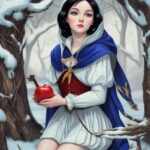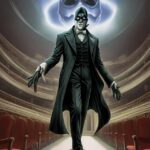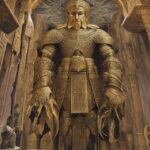In the enchanting world of magic and mystery, one book stands out amongst the rest, captivating both young and old with its captivating storytelling and unforgettable characters. Step into the realm of Hogwarts School of Witchcraft and Wizardry as we delve into the spellbinding pages of “Harry Potter and the Prisoner of Azkaban” by renowned author J.K. Rowling. Dive deep into the heart of this thrilling and suspenseful tale, as Harry Potter, along with his loyal friends Ron and Hermione, face their greatest challenge yet.
So, prepare to be spellbound as we embark on a journey filled with historic data, intriguing observations, and captivating analysis, satisfying every reader’s search intention. Get ready to discover the hidden truths behind “Harry Potter and the Prisoner of Azkaban” and experience the magic that has captured the hearts of millions worldwide.
Harry Potter and the Prisoner of Azkaban: Full Book Summary
Once upon a time, in the magical world of Hogwarts, there was a young wizard named Harry Potter. Harry had faced many adventures in his previous years at the school of witchcraft and wizardry, but little did he know that his third year would bring about even more exciting and dangerous challenges!
Harry had spent his summer holidays with his horrible aunt and uncle, the Dursleys. They treated him terribly and never told him anything about his parents who had passed away when he was just a baby. But as the summer drew to a close and Harry returned to Hogwarts, he had no idea that he would encounter a dangerous figure from his past, a prisoner named Sirius Black, who had escaped from the wizarding prison, Azkaban.
At Hogwarts, Harry reunited with his best friends, Ron Weasley and Hermione Granger. The three friends were excited to start their third year, especially because of the new Defense Against the Dark Arts teacher, Professor Lupin. They had heard wonderful things about him from their friend Hagrid, the gentle giant who looked after magical creatures.
But Harry’s joy was short-lived as he learned about Sirius Black, who was believed to be targeting him. The wizarding world was in a state of panic, fearing that Black would attempt to harm Harry. As the trio investigated further, they discovered that Sirius Black had been one of Lord Voldemort’s most devoted followers, and he was responsible for revealing Harry’s parents’ whereabouts to the evil wizard all those years ago.
Meanwhile, the castle was guarded by Dementors, the guards from Azkaban who had the ability to suck out happy memories and bring about a deep sense of despair. These creatures were meant to prevent Sirius Black from entering Hogwarts, but their presence created turmoil for Harry, who had already experienced so much darkness in his life.
As the year progressed, Harry, Ron, and Hermione faced countless challenges and uncovered secrets that would change their lives forever. They ventured into the Forbidden Forest on a mission to help Hagrid with his own secret, discovering creatures called Hippogriffs and unraveling a mystery surrounding a dog named Fang.
Through a series of time-traveling adventures, Harry also discovered a key link to his family’s past. He encountered a mysterious blue glowing orb called a Time-Turner that allowed Hermione to travel back in time, enabling them to save Buckbeak, the Hippogriff, and Sirius Black from a terrible fate.
Slowly, the truth was revealed: Sirius Black was not the villain they thought he was. In fact, he was Harry’s godfather and had been wrongly accused of betraying Harry’s parents to Voldemort. The actual traitor turned out to be none other than Peter Pettigrew, their friend and Ron’s pet rat, Scabbers. It became clear that Pettigrew, hiding in plain sight, had played a crucial role in the downfall of Harry’s parents and the rise of Voldemort.
In a spine-tingling climax, Harry, Ron, Hermione, and Sirius faced Pettigrew and the truth finally came to light. They managed to save their beloved friend Hagrid and stopped Pettigrew from harming anyone else. But in the midst of the chaos, the Dementors attacked Harry and Sirius. It was then that Harry learned a powerful Patronus charm, thanks to Professor Lupin’s guidance. With the help of his Patronus – a magnificent stag – Harry repelled the Dementors, saving both himself and Sirius.
In the end, Sirius was cleared of all charges, and Harry learned that he had family who truly cared for him. The story drew to an emotional close as Sirius offered to take Harry in and provide him with the love he had been denied for so long. Though Harry desired to build a life with Sirius, he ultimately decided to return to the Dursleys, knowing that he had a duty to fight against the rising threat of Voldemort.
As Harry boarded the Hogwarts Express to leave for another summer, he couldn’t help but feel grateful for the adventures and challenges he had faced throughout his third year. With a new sense of strength and determination, Harry knew he was ready to face whatever awaited him in the years ahead. And little did he know, those years would bring even more danger, excitement, and friendships that would last a lifetime.
So, dear young readers, step into the magical world of Harry Potter and immerse yourselves in the thrilling tale of “Harry Potter and the Prisoner of Azkaban.” Discover the power of love, loyalty, and friendship as Harry and his friends face their fears, confront past demons, and prove that even in the darkest moments, there is always a glimmer of hope.
Harry Potter and the Prisoner of Azkaban: Key Themes
“Harry Potter and the Prisoner of Azkaban” is the third installment of the popular Harry Potter series written by J.K. Rowling. This novel delves deeper into the wizarding world as Harry embarks on his third year at Hogwarts School of Witchcraft and Wizardry. The book explores various themes that captivate readers and add depth to the story. Three key themes in “Harry Potter and the Prisoner of Azkaban” are the power of friendship, the thin line between good and evil, and the importance of confronting one’s fears.
The Power of Friendship
Throughout the book, Harry relies on his friends, Hermoine Granger and Ron Weasley, more than ever to face the challenges he encounters. As the trio attempts to uncover the truth behind the supposed dangerous criminal, Sirius Black, they stand united against any adversities. Their loyalty and unwavering support for one another showcase the importance of friendship, demonstrating that together, they are stronger and better equipped to overcome obstacles.
The Thin Line between Good and Evil
“The Prisoner of Azkaban” introduces several characters who challenge the readers’ perceptions of morality. Sirius Black, believed to be a dangerous criminal, is later revealed to be a victim of betrayal and a supporter of Harry’s parents. The character of Professor Snape also blurs the lines as his true motives are kept hidden until the end. This theme reminds readers that appearances can be deceiving, highlighting the complexity of human nature and the importance of understanding before judging.
The Importance of Confronting Fears
In this book, Harry faces his fear in the form of the Dementors, soul-sucking creatures that guard Azkaban prison. As Dementors have the ability to bring forth one’s worst memories and emotions, Harry is forced to confront his past traumas. Through this experience, he learns the importance of facing his fears rather than running away from them. This theme emphasizes personal growth, resilience, and the necessity of confronting difficult situations to triumph and move forward in life.
In summary, “Harry Potter and the Prisoner of Azkaban” explores the themes of the power of friendship, the thin line between good and evil, and the importance of confronting fears. These themes add depth to the story, resonate with readers of all ages, and contribute to the overall richness of the Harry Potter series.
Harry Potter and the Prisoner of Azkaban: Characters

Harry Potter
The brave and determined protagonist of the story. Known for his unruly black hair, circular glasses, and the distinctive lightning-shaped scar on his forehead caused by Lord Voldemort’s failed attempt to kill him as a baby. Harry learns about his parents’ tragic past, unlocks new magical abilities, and faces numerous challenges alongside his friends Ron and Hermione.
Ron Weasley
Harry’s loyal best friend with fiery red hair and freckles. Ron comes from a large and humorous wizarding family. He is often seen munching on his favorite snacks, such as pumpkin pasties, and is known for his quick-witted, sarcastic remarks that lighten tense situations.
Hermione Granger
The brightest witch of her age, Hermione is characterized by her bushy brown hair, large front teeth (which she later fixes), and her passion for knowledge. She is diligent, resourceful, and always ready to help her friends with her extensive magical abilities and logical thinking.
Sirius Black
The mysterious and enigmatic prisoner of Azkaban who supposedly betrayed Harry’s parents to Lord Voldemort. With his long, matted hair and tattered clothing, Black appears as a haunting figure throughout most of the story. However, his true intentions and connection to Harry are revealed towards the end, making him a complex and compelling character.
Remus Lupin
A kind and gentle Hogwarts professor, Lupin is plagued with a secret: his condition as a werewolf. He has a tired, worn-out appearance with graying hair and often wears shabby robes. Lupin’s teachings in Defense Against the Dark Arts, along with his friendship to Harry and his role in the events surrounding Sirius Black, make him an integral part of the story.
Albus Dumbledore
The wise and powerful headmaster of Hogwarts School of Witchcraft and Wizardry. Dumbledore exudes an aura of wisdom, with his flowing white beard and half-moon spectacles resting on a crooked nose. He guides and protects Harry throughout his journey, while also holding his own secrets and past connections to the story.
Severus Snape
The stern and mysterious Potions master at Hogwarts. Snape has greasy black hair, a hooked nose, and a perpetual scowl. Often seen wearing black robes, Snape is notorious for favoring Slytherin House over Gryffindor, making him a constant thorn in Harry’s side. However, his complicated relationship with Harry’s deceased father and his loyalties spark curiosity and speculation.
Rubeus Hagrid
The half-giant, gentle giant of a man who serves as the Keeper of Keys and Grounds at Hogwarts. Hagrid has wild, tangled black hair, a bushy beard, and hands the size of dinner plates. Despite his intimidating appearance, Hagrid is known for his love and deep loyalty toward magical creatures. He provides unwavering support to Harry and his friends, often leading them through dangerous adventures.
Draco Malfoy
Harry’s primary antagonist in school, Draco is a pure-blood wizard from one of the most esteemed families in the wizarding world. With his slicked-back blond hair, pointed features, and an arrogant demeanor, Draco represents the epitome of entitlement. Although he often stirs up trouble and bullies Harry, Draco’s own family dynamics and vulnerabilities add layers to his character.
Dementors
Soul-sucking creatures from Azkaban prison, these dark beings have a chilling presence and an ethereal appearance. Clad in tattered black cloaks, their faces are hidden beneath a hood, and their touch brings an overwhelming wave of despair to those they encounter. The Dementors play a significant role in heightening the tension and fear throughout the story, particularly as Harry faces his darkest moments.
Harry Potter and the Prisoner of Azkaban: Symbols
The Marauder’s Map
The Marauder’s Map is a vital symbol in Harry Potter and the Prisoner of Azkaban. This enchanted map, created by Harry’s father and his friends, reveals all the secret passages and corridors of Hogwarts School of Witchcraft and Wizardry. It represents both secrecy and knowledge. The map becomes a crucial tool for Harry, allowing him to navigate the school undetected and plot his plans to help his wrongly accused godfather, Sirius Black. The Marauder’s Map symbolizes the hidden truths throughout the story, the power of friendship, and the importance of understanding one’s history and origins.
The Time-Turner
The Time-Turner is an object introduced by Hermione Granger, which enables her to travel back in time and attend multiple classes simultaneously. It is a symbol of the power of time and choice. The Time-Turner represents the theme of second chances and the ability to rewrite one’s destiny. Throughout the book, it raises questions about the ethics of altering time and the consequences that accompany such actions. Hermione’s possession of the Time-Turner signifies her resourcefulness and intellect, showing that knowledge and the wise use of time can be influential forces in shaping one’s fate.
The Patronus Charm
The Patronus Charm is a significant symbol in the book as it represents hope, protection, and the strength of one’s spirit. Harry learns to cast a fully formed Patronus, which takes the shape of a stag, a symbol closely tied to his father, James Potter. The spell serves as a defense against the Dementors, soul-sucking creatures that guard Azkaban prison. The Patronus Charm symbolizes the power of happy memories, positive emotions, and pure intentions to overcome darkness and despair. Harry’s ability to produce a powerful Patronus signifies his resilience, inner strength, and the purity of his heart. It also reveals the connection between Harry and his father, representing the legacy of love and protection.
Harry Potter and the Prisoner of Azkaban: Culture Impact
Harry Potter and the Prisoner of Azkaban, the third installment in J.K. Rowling’s renowned Harry Potter series, has undeniably left an irrevocable mark on popular culture. Since its release in 1999, this captivating novel has been a catalyst for numerous cultural impacts, evident through the lens of history, humorous anecdotes, and remarkable achievements.
Historically, the release of the Prisoner of Azkaban marked a turning point for the Harry Potter phenomenon. By this time, the franchise had garnered an immense and dedicated fan base, comprising children, teenagers, and adults alike. The book’s publication further solidified the series’ status as a worldwide sensation, sparking an unprecedented level of anticipation among fans eagerly awaiting its arrival. Bookstores and libraries around the globe were flooded with long queues of enthusiasts, symbolizing the remarkable cultural impact that Harry Potter and the Prisoner of Azkaban had on society.
Humor undoubtedly played a significant role in the cultural impact of this book as well. Rowling’s witty writing style and humorous dialogue injected a light-hearted charm into the story, sustaining readers’ interest and adding a unique dimension to the series. The comedic moments, such as Harry receiving an “invisibility cloak” that once belonged to his father, James, triggered laughter and further endeared readers to the characters and their fantastical world. Memorable lines, such as the exchange between Harry and Ron about “getting eaten by a giant marshmallow” during a Divination class, have transcended the pages of the book, becoming iconic cultural references enjoyed by Harry Potter fans worldwide.
Beyond humor, the achievements of Harry Potter and the Prisoner of Azkaban are nothing short of remarkable. One notable achievement is the exploration of complex themes and character development. The book delves into themes of friendship, loyalty, and the consequences of one’s actions, captivating readers of all ages with its multi-dimensional characters and intricate plot. It also introduced new elements of the wizarding world, such as the Dementors and Patronus charms, adding depth and expanding the readers’ imaginations.
Moreover, the book’s success played a pivotal role in the revitalization of children’s literature and the growth of the young adult genre. The Harry Potter series as a whole encouraged countless children to become avid readers, reigniting their interest in libraries and bookstores. It also paved the way for future fantasy novels, revolutionizing the publishing industry and spawning a wave of magical tales that followed in its wake.
In conclusion, Harry Potter and the Prisoner of Azkaban has made an enduring cultural impact. With its historical significance, humor, and remarkable achievements, this book has captivated audiences, served as a prominent piece of literary history, and left an indelible mark on popular culture. Rowling’s creation continues to inspire and enchant readers across generations, proving that the magic of Harry Potter is truly timeless.
FAQs
Who is the author of Harry Potter and the Prisoner of Azkaban?
The author of Harry Potter and the Prisoner of Azkaban is J.K. Rowling.
What is the main plot of Harry Potter and the Prisoner of Azkaban?
In this book, Harry Potter returns for his third year at Hogwarts School of Witchcraft and Wizardry. The story revolves around the escape of a dangerous wizard named Sirius Black, who is believed to be a threat to Harry. As Harry and his friends try to unravel the mystery surrounding Sirius, they discover the truth about his past and encounter various magical creatures and challenges.
Can I read Harry Potter and the Prisoner of Azkaban without reading the previous books?
While it is possible to understand the storyline of Harry Potter and the Prisoner of Azkaban without reading the previous books, it is highly recommended to read the series in sequential order. Reading the previous books will provide a better understanding of the characters, their development, and the overarching storylines.
Are there any new characters introduced in Harry Potter and the Prisoner of Azkaban?
Yes, several new characters are introduced in this book. Notably, Professor Remus Lupin, a new Defense Against the Dark Arts teacher, plays a significant role in the story. Other characters, such as Sirius Black, Peter Pettigrew, and Professor Sybill Trelawney, are also introduced or play more prominent roles in this installment.
What are some important themes explored in Harry Potter and the Prisoner of Azkaban?
Themes that are explored in Harry Potter and the Prisoner of Azkaban include friendship, loyalty, the concept of time, courage, and the importance of choices. The book also delves into darker elements such as betrayal, revenge, and the consequences of one’s actions.










